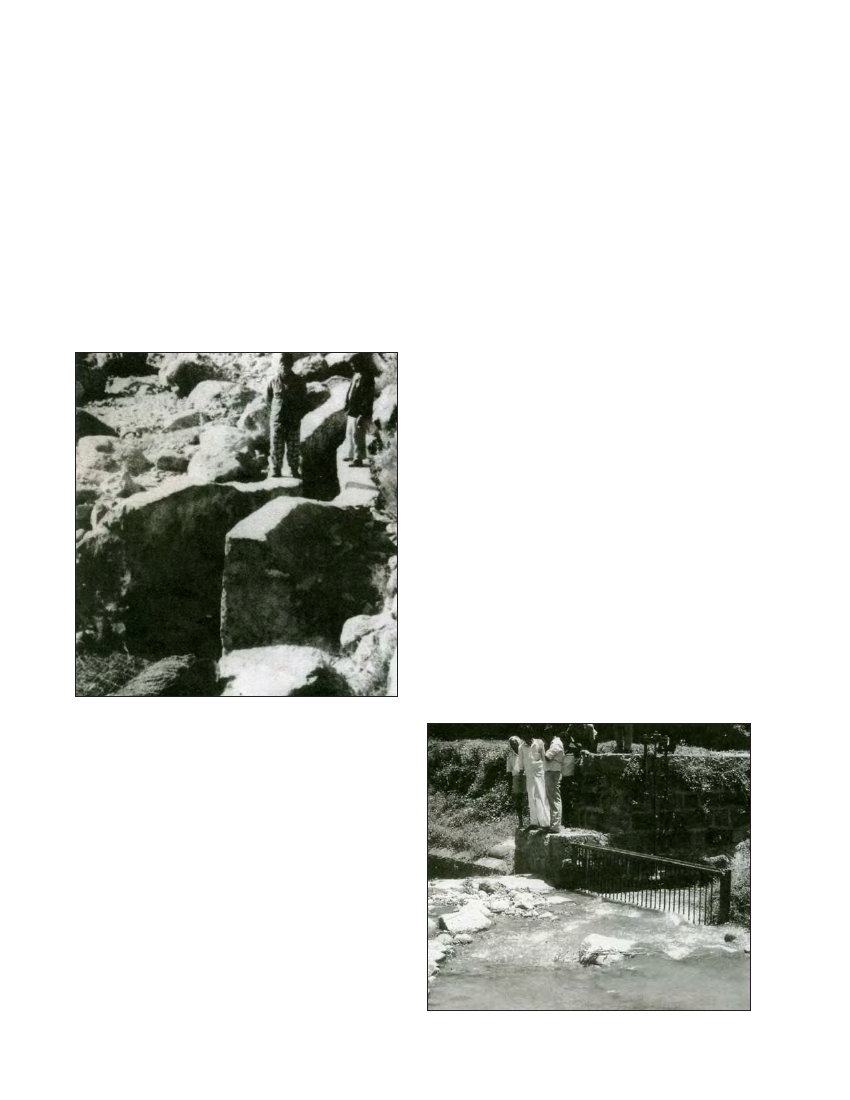
24 CIVIL WORKS GUIDELINES FOR MICRO-HYDROPOWER IN NEPAL
3.5 Side intake
3.5.1 DESCRIPTION
Side intakes are simple and less expensive than other types
of intake. They are easy to build, operate and maintain. Side
intakes are similar to farmers' traditional intakes for irrigation,
and hence the farmers can quickly learn the principles of
operation and maintenance of these intakes. The side intake
of the 50 kW Galkot micro-hydro scheme can be seen in Photo-
graph 3.2. Note that to minimise flood flows in the canal, the
intake is designed as an extension of the headrace canal. It
was felt that the intake could be vulnerable to flood damage
and therefore the coarse trashrack is located further
downstream.
Photo 3.2 Side intake of the Galkot micro-hydro scheme, Baglung,
Nepal (see Appendix C for drawing)
A side intake without a weir is unlikely to be suitable for river
Types 1C, 2B and 2C, due to the strong possibility of the river
course shifting in the future.
Side intake with weir
The function of a weir is to raise the water level in order to
ensure a constant minimum depth of water upstream of the
weir. This allows the required flow to be diverted to the
headrace as long as there is sufficient water in the river.
Types of weir are described in Section 3.6.
Side intake with and without gate
Gate(s) should be provided for a side intake if the river is
relatively large and thus inflows into the intake need to be
regulated, and at times stopped, such as during emergency or
maintenance work. However if the river flow is low then gates
may not be essential and only provision for a spillway
downstream of the intake may be sufficient. One should note
that provision of orifice like structures (can be as simple as a
wall on top of intake canal) will help to control entry of excessive
flows during floods. However, even with an orifice, some higher
flows (than required for full power generation) will enter the
intake during flood events. Thus, immediately downstream of
the intake a spillway should be provided at an appropriate
location so that only the desired flow is conveyed further
downstream. This will both enhance the performance of the
structures downstream (e.g., gravel trap and settling basin)
and reduce risks due to uncontrolled overflows. In such a case
the canal between the intake and the spillway should also be
capable of handling excess water that enters during flood.
3.5.2 TRASHRACKS FOR SIDE INTAKES
The trashracks for side intakes can be manufactured from flat
steel, angles, tees or round bars welded together at fixed
intervals. The trashrack at the intake is also known as “coarse
trashrack” since the bar spacing is wider here compared to
Side intakes must be safe against boulder impact and
floodwater entry. They are most effective when built on the
outer bend of the river (to minimise the amount of sediment
drawn into the intake), near natural pools or sited in such a
way that they are protected as much as possible from river
floods (e.g. behind a permanent rock outcrop). Side intakes
can be used with or without a weir.
Side intake without weir (natural pond)
In some cases, an exposed intake structure may be avoided
by extracting water from behind the shelter of a rock outcrop.
In other cases, there may be a natural cleft in a rock spur, or an
opening between a very large boulder and a rock wall, that
can be used as a natural intake. Wherever possible, this type
of intake should be preferred, since it is the most economical
one, and safe from the damage of floods and debris materials.
It also maintains the principle of “minimal disturbance to the
natural state of river”.
Photo 3.3 Where an intake is liable to attract floating debris a
trashrack may be necessary ( Sri Lanka )